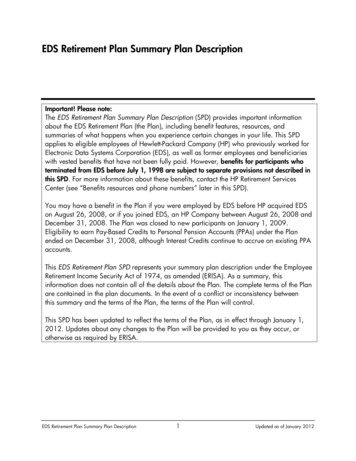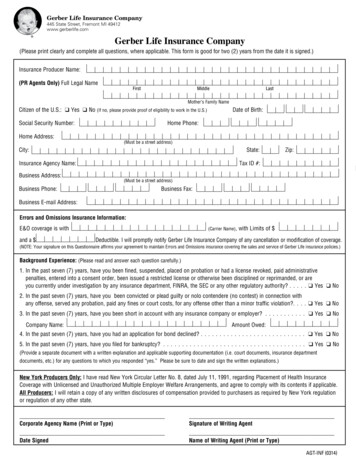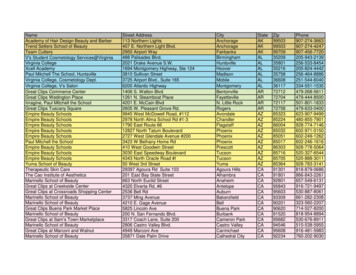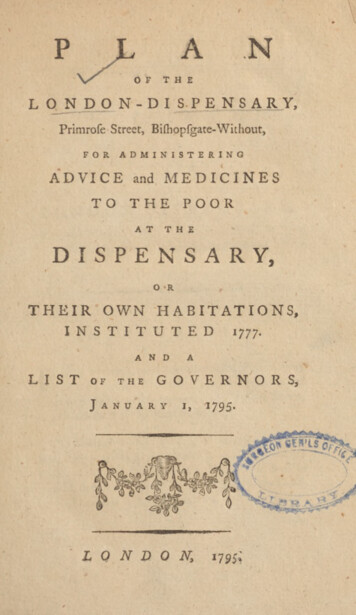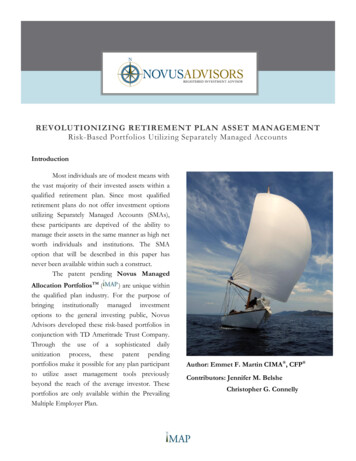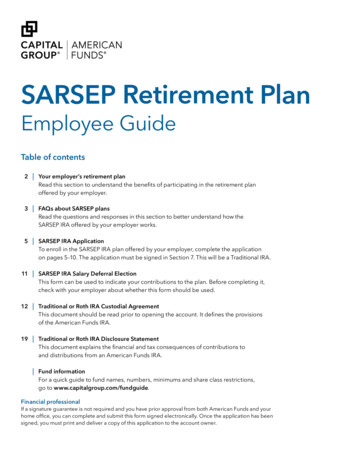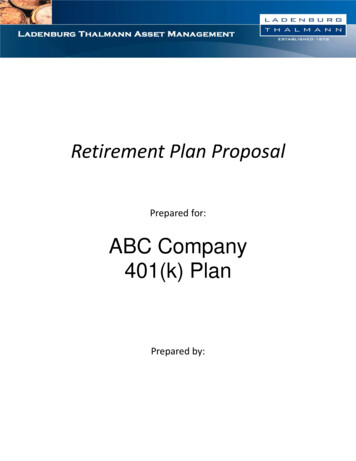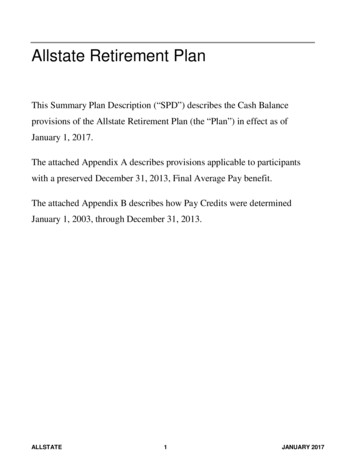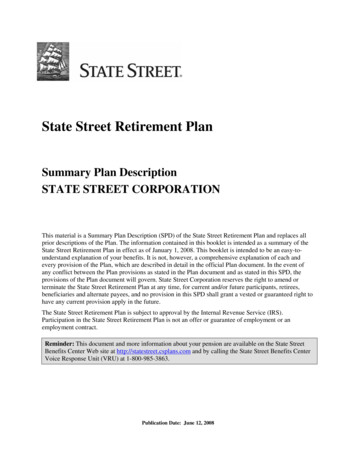
Transcription
State Street Retirement PlanSummary Plan DescriptionSTATE STREET CORPORATIONThis material is a Summary Plan Description (SPD) of the State Street Retirement Plan and replaces allprior descriptions of the Plan. The information contained in this booklet is intended as a summary of theState Street Retirement Plan in effect as of January 1, 2008. This booklet is intended to be an easy-tounderstand explanation of your benefits. It is not, however, a comprehensive explanation of each andevery provision of the Plan, which are described in detail in the official Plan document. In the event ofany conflict between the Plan provisions as stated in the Plan document and as stated in this SPD, theprovisions of the Plan document will govern. State Street Corporation reserves the right to amend orterminate the State Street Retirement Plan at any time, for current and/or future participants, retirees,beneficiaries and alternate payees, and no provision in this SPD shall grant a vested or guaranteed right tohave any current provision apply in the future.The State Street Retirement Plan is subject to approval by the Internal Revenue Service (IRS).Participation in the State Street Retirement Plan is not an offer or guarantee of employment or anemployment contract.Reminder: This document and more information about your pension are available on the State StreetBenefits Center Web site at http://statestreet.csplans.com and by calling the State Street Benefits CenterVoice Response Unit (VRU) at 1-800-985-3863.Publication Date: June 12, 2008
What’s InsideHighlights. 1Eligibility . 1Participation . 2Your Beneficiary. 2Naming Your Beneficiary. 2If You Have a Spouse . 3If You Do Not Have a Spouse . 3If There Is No Named Beneficiary. 3Changing Your Beneficiary . 4Plan Costs . 4Individual Accounts . 4Basic Credits . 4Special Transition Credits. 4Interest Credits . 6Vesting . 6Vesting Service . 7Accessing Your Retirement Plan Account. 7Account Statements . 7Receiving Your Vested Plan Benefit . 8Normal Forms of Payment. 8Optional Forms of Payment . 8Required Spousal Consent for Optional Forms of Payment . 9If Your Account Balance Is 5,000 or Less. 9If You Are Not Vested . 10If You Are Employed After Age 70½. 10Taxation of Pension Benefits . 10In the Event of Your Death . 10If You Take a Leave of Absence . 10Long Term Disability. 10Other Leaves of Absence . 11Military Leave. 11
When Participation Ends. 11If You Leave the Company and Are Rehired. 11Special Provisions in the Event of Merger or Acquisition. 12General Retirement Plan Information . 15Assignments and Liens . 15Qualified Domestic Relations Orders (QDROs). 15Plan Continuation. 15Top-Heavy Rules . 16Claims and Appeal Procedures . 16Submitting an Appeal . 17What Happens When . 18Administrative Information . 19Plan Information . 19Plan Administrator . 20Plan Sponsor . 20Trustee of the State Street Retirement Plan . 20Agent for Legal Process. 20Plan Fiduciary Responsibility . 20IRS Approval . 21Pension Trust Fund and Plan Trustee . 21Pension Benefit Guaranty Corporation . 21Your ERISA Rights . 21Receive Information About Your Plan and Benefits . 22Prudent Actions by Plan Fiduciaries. 22Enforce Your Rights . 22Assistance With Your Questions . 22Appendix A: Special Subsidies for Employees Hired on or Before December 31, 1989 (GrandfatheredBenefit) . 24Grandfathered Benefit Frozen as of August 31, 2003. 24Grandfathered Benefit. 24Grandfathered Benefits Prior to Age 65 . 25Death Benefit . 25Notes on the Grandfather Benefit . 25Appendix B: Enhanced Benefits Under the 2003 Voluntary Separation Program . 26Rehire of 2003 Voluntary Separation Program Participants. 26
Enhanced Benefits for Certain Employees of International Deposit Services and Private AssetManagement. 27For More Information . 27
HighlightsThe State Street Retirement Plan (the Retirement Plan or Plan) is a cash balance plan that provides abenefit to supplement your retirement income from other sources such as the State Street Salary SavingsProgram (the 401(k) Plan or SSP), Social Security, and your personal investments and savings.The Retirement Plan is frozen to all new participants effective January 1, 2008. This means that becausethe Plan has a one-year service requirement and a quarterly participation date, if you were hired by StateStreet after October 1, 2006, you will not have met the service requirements on or before January 1, 2008(the date the plan is frozen to new participants) and you will not become eligible for benefits under thisPlan.If you were an active participant in the Plan as of January 1, 2008 the following information applies toyou: The Company will not make any contributions to the Plan after December 31, 2007. However,the value of your retirement benefit will continue to grow by earning Interest Credits each year. Certain older, longer-service participants receive Special Transition Credits. After you complete three years of service or reach age 65 (whichever occurs sooner), you have avested retirement benefit. (Prior to January 1, 2008, you needed to complete at least five years ofservice or attained age 65 to have a vested retirement benefit.) Certain Grandfathered benefits (described in Appendix A) remain unchanged – you receive thegreater of the two benefits when you retire from State Street at age 55 or older.This SPD describes the key features of the Retirement Plan and applies to eligible employees of StateStreet. Complete details of the Retirement Plan can be found in the official Plan document, which legallygoverns the operation of the Retirement Plan. All statements made in this SPD are subject to the termsand provisions of the Plan document and are not intended to create new Plan provisions or change theRetirement Plan in any way.State Street reserves the right to amend or terminate the Retirement Plan at any time, for current and/orfuture participants, retirees, beneficiaries and alternate payees, and no provision in this SPD shall grant avested or guaranteed right to have any current provision apply in the future. If there is a conflict betweenthe Retirement Plan document and this summary, the official Retirement Plan document is the controllingdocument.EligibilityAs of January 1, 2008Effective as of January 1, 2008, the plan is frozen to new participants.Prior to January 1, 2008You are eligible to participate in the Retirement Plan on and after the first day of the calendar quarter(January 1, April 1, July 1 or October 1) after you: Attain the age of 21 and1Publication Date: June 12, 2008
Complete one year of employment at State Street, provided you have worked at least 1,000 hours ofservice during any one-year period that begins on your date of hire or on any anniversary of your dateof hire.Definition of Hours of ServiceFor purposes of determining your eligibility to participate in the Plan, “hours of service” means each hourfor which you are paid, or are entitled to be paid, by State Street or an affiliated employer. For periodsduring which you are not performing any duties but are being paid, including vacation time, holidays,illness, incapacity, disability, jury duty or leave of absence, but not including absence due to militaryduty, you will be credited with not more than 501 hours of service for eligibility purposes with respect toany one single period of continuous absence.You are not eligible to participate in the Retirement Plan if you are: A nonresident alien who receives no income from a participating employer that is considered incomefrom within the United States; A student who participates in an internship program or is employed in an established cooperativeeducation program; An employee of an affiliated company that does not participate in the Retirement Plan; An independent contractor, consultant or leased employee; or A member of a unit that is covered by a collective bargaining agreement (unless such agreementprovides for eligibility to participate).ParticipationIf you are a vested participant but no longer meet the eligibility requirements because you terminate fromthe Company, you may take a distribution or you may keep your account in the Plan if its value is morethan 5,000. If your account value is 5,000 or less, you must take a full distribution from the Plan. If youno longer meet the Plan’s eligibility requirements because you have been transferred to a subsidiary thatis not a participating employer in this Plan, your account will be maintained but you will not be entitled toa distribution until you terminate from State Street or one of its subsidiaries.Your BeneficiaryYour beneficiary is the person who will receive a distribution of your account balance if you die beforeyou begin receiving benefits from the Plan. Your beneficiary designation remains in effect until youchange it, whether or not you are still employed by State Street. If you die after benefits have begun, orafter you have completed and filed your benefit election form, any survivor benefit, if any, will be paid toyour named beneficiary according to the form of payment you elected.Naming Your BeneficiaryThe full value of your Retirement Plan benefit will be payable to your designated beneficiary(ies) at yourdeath if they survive you. Naming a beneficiary is important. You may choose or change yourbeneficiary(ies) by logging in at http://statestreet.csplans.com, going to the “2008 Health and WelfareInfo” section and selecting “Forms“ then select “Other Forms/Add’l Docs.” You may download andcomplete the Retirement Plan beneficiary form to name your beneficiary(ies) for your Retirement Plandeath benefit.2Publication Date: June 12, 2008
You will be able to name primary beneficiary(ies) and contingent (or secondary) beneficiary(ies) shouldyour primary beneficiary(ies) not survive you.Definition of SpouseFor purposes of the Retirement Plan, the term “spouse” means your partner, as recognized under the lawsof the applicable state or lawful jurisdiction as married or, in the case of a domestic partner, as a legallyrecognized partner (e.g., registered partner or partner in a civil union).If you have a domestic partner who is not your legally recognized partner, you may still name him or heras your beneficiary. However, he or she is not considered a spouse under the Retirement Plan and doesnot have the same rights as a spouse (i.e., you do not need his or her consent to name a differentbeneficiary or to choose an optional form of payment).Definition of Federal SpouseFor purposes of the Retirement Plan, the term “Federal Spouse” means a Spouse as determined underapplicable federal law which is defined as the legal union between a man and a woman as a husband andwife and does not-include same-sex marriages or domestic partnerships.If You Have a SpouseYour spouse is automatically the beneficiary of your Retirement Plan benefit unless you name analternative beneficiary with your spouse’s consent after you reach age 35. Your spouse’s consent must bewitnessed by a notary public. If the Plan Administrator has not received this consent, your spouse will beconsidered your beneficiary if you die, regardless of the beneficiary you may have designated.Before providing consent, it is important for your spouse to understand what it means to waive his or herrights. Your spouse may not unilaterally withdraw consent once given.Spousal consent is required unless it is established to the satisfaction of the Plan Administrator that: Spousal consent cannot be obtained because there is no spouse; The spouse has died; The spouse cannot be located (based on an independent investigation); or There is a court order certifying that you are legally separated from your spouse, or have beenabandoned by the spouse and a Qualified Domestic Relations Order does not otherwise requirespousal consent.If your spouse is not legally competent, his or her legal guardian (even if it is you) may give consent onbehalf of your spouse.If You Do Not Have a SpouseIf you do not have a spouse, you may name anyone as your beneficiary. If you have a domestic partnerwho is not your legally recognized partner, he or she does not need to give consent for you to name adifferent beneficiary. If more than one beneficiary becomes
Jun 26, 2008 · The Retirement Plan is frozen to all new participants effective January 1, 2008. This means that because the Plan has a one-year service requirement and a
